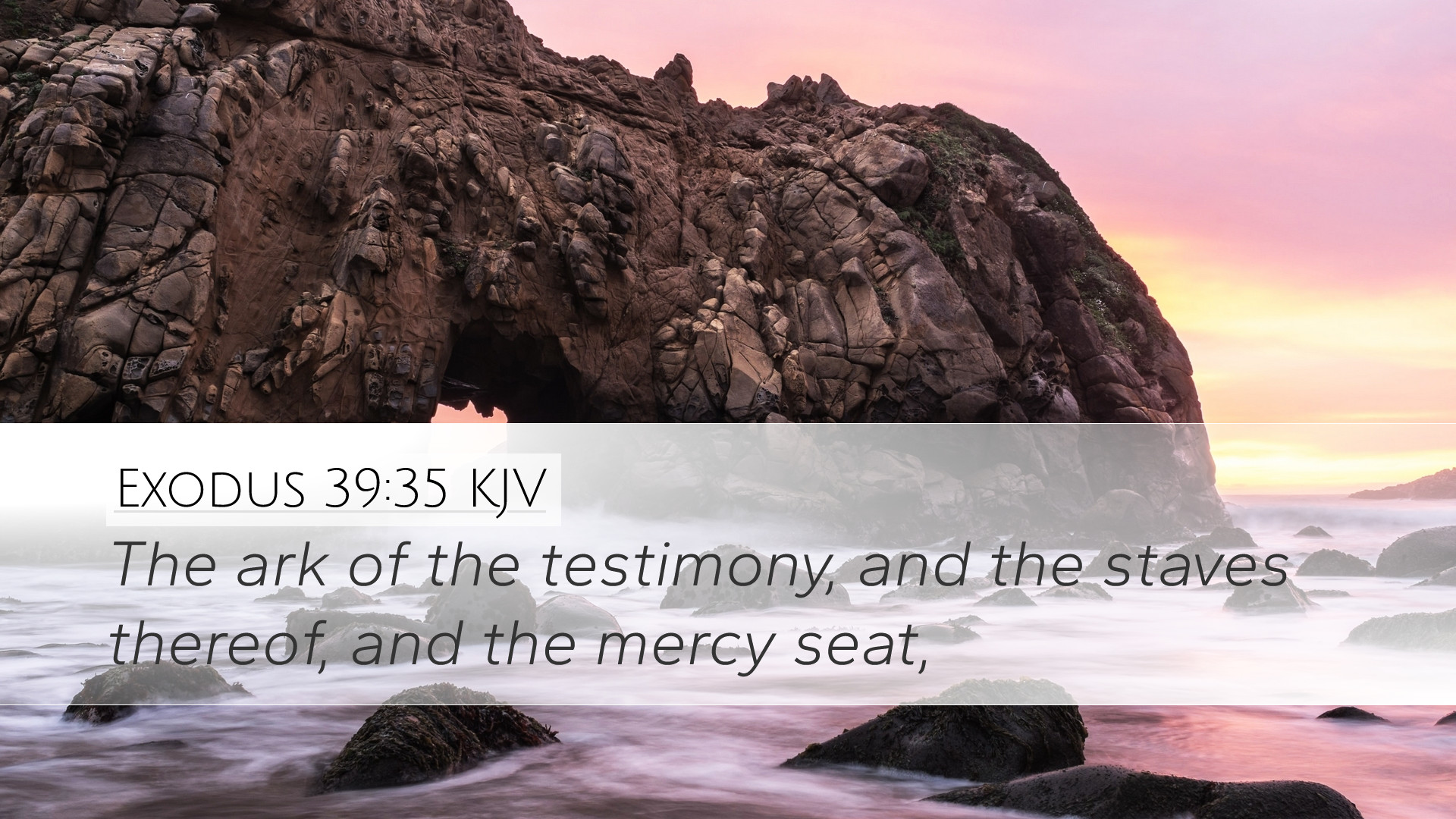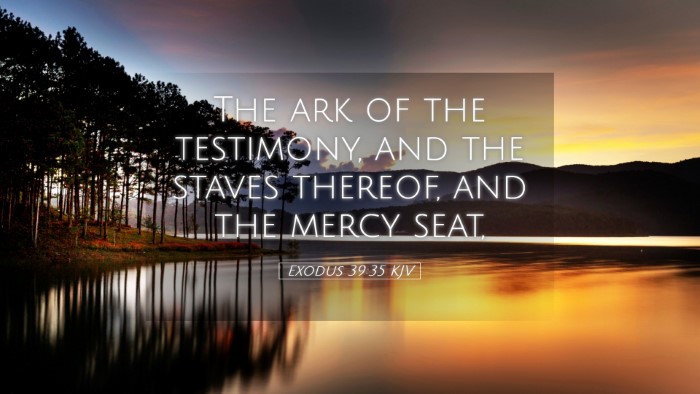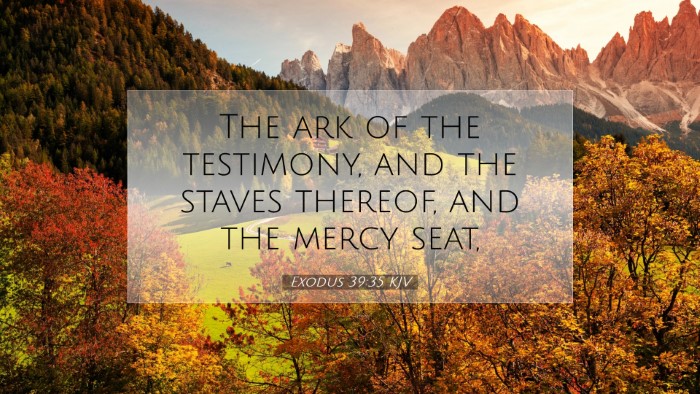Commentary on Exodus 39:35
Verse: "The ark of the covenant with the staves thereof, and the mercy seat, and the veil of the covering." (Exodus 39:35)
Introduction
This verse concludes the detailed account of the garments, instruments, and furnishings related to the Tabernacle's construction. The mention of the ark of the covenant underscores its supreme importance in the worship and relationship between God and His people. Various commentaries provide insights into the theological, historical, and practical implications of this verse, shedding light on its significance in the biblical narrative.
The Ark of the Covenant
Matthew Henry Commentary: Matthew Henry describes the Ark of the Covenant as the most sacred object of the Tabernacle, serving as a symbol of God's presence among His people. It contained the tablets of the Law, signifying the covenant between God and Israel. The ark's design and materials reflect divine instruction, emphasizing that the worship of God must adhere to His specifications.
Albert Barnes Commentary: Barnes reinforces the idea that the ark represents the very throne of God on earth, a meeting point between the divine and humanity. The staves, or poles, allowed for the ark to be carried, indicating a dynamic relationship in which God travels with His people. This speaks to God's immanence and transcendence, as He is both separate and yet close to His creation.
Adam Clarke Commentary: Clarke elaborates that the Ark was not just a chest; it was a part of the ceremonial life of the Israelites, serving as a physical representation of God's promise and faithfulness. He notes its intricate design and states that the ark's construction foreshadows greater spiritual truths, which are ultimately fulfilled in Jesus Christ, representing the true fulfillment of God’s covenant with humanity.
The Mercy Seat
Matthew Henry Commentary: Henry further explains the significance of the mercy seat, which sat atop the ark. It was here that God would meet with Moses and give directions for the people. This position of the mercy seat as the cap of the ark speaks of Christ being the ultimate mercy and atonement, fulfilling the roles of high priest and sacrifice.
Albert Barnes Commentary: Barnes points out that the original Hebrew name for the mercy seat, "Kapporet," connotes a place of propitiation. This aspect is essential for understanding the sacrificial system laid out in the subsequent books and the themes of mercy and judgment. The mercy seat symbolizes God’s desire to extend grace to sinners while upholding His justice.
Adam Clarke Commentary: Clarke notes that the mercy seat’s terminology reflects inclusivity in God’s nature, indicating that He invites mankind to find grace before Him. The connection made between this seat of mercy and locations of worship speaks to the intention of God to restore His relationship with humanity through reconciliation and mercy.
The Veil of the Covering
Matthew Henry Commentary: The veil represents the separation between God and His people, a crucial theme in Exodus. Henry writes that it signifies the holiness of God and the barriers that sin puts between Him and humanity. In the New Testament, the tearing of the veil at Christ’s crucifixion symbolizes the removal of that separation.
Albert Barnes Commentary: Barnes elaborates on the function of the veil in the Tabernacle, serving to protect the holy things from the unclean. He emphasizes that this reflects God’s holiness and the seriousness with which He regards approaching Him. The veil’s function points forward to Christ as the mediator whose sacrifice opens access to God.
Adam Clarke Commentary: Clarke identifies the veil as critical for understanding the need for atonement. It served to mandate that the sinful cannot approach a holy God without reconciliation. The narrative demonstrates God’s desire for relationship, illustrated throughout Scripture, ultimately culminating in Christ’s redemptive work.
Theological Implications
The details of this verse serve as rich symbolisms that highlight the relationship between God and His people. Each element—the Ark, the mercy seat, and the veil—carries profound theological weight.
- The Presence of God: The Ark symbolizes God’s dwelling among His people, which is a recurring theme throughout the scriptures.
- God’s Holiness: The veil signifies the impenetrable holiness of God, reinforcing the need for a mediator and highlighting the gravity of approaching God.
- Redemption and Atonement: The mercy seat foreshadows the redemptive work of Christ, who offers mercy and reconciles humanity with God.
- Covenant Relationship: The inclusion of the staves reflects an ongoing journey of faith for Israel, demonstrating God’s desire to lead His people, signifying a living relationship.
Practical Applications
Pastors, students, and scholars can draw several applications from Exodus 39:35:
- Understanding Worship: The significance of the Ark and its furniture in worship can inform Christian practices, reminding believers of the importance of reverence in approaching God.
- Emphasis on God’s Holiness: The veil prompts reflection on the nature of sin and the seriousness of approaching a holy God.
- Focus on Redemption: The mercy seat as a symbol of atonement encourages reflection on the continued relevance of Christ’s sacrifice for all believers.
- Commitment to God’s Guidance: The staves of the Ark challenge believers to trust in God’s guidance throughout their life’s journey.
Conclusion
Exodus 39:35 serves as a powerful reminder of God's holy presence. It balances the themes of separation and accessibility. Through the careful construction of the Tabernacle, God demonstrates His desire to dwell with humanity while upholding His holiness. This verse resonates with the overarching biblical narrative of redemption and ultimately points to Jesus Christ as the fulfillment of God's covenant with humanity.


